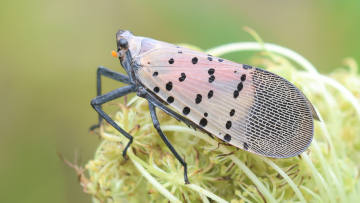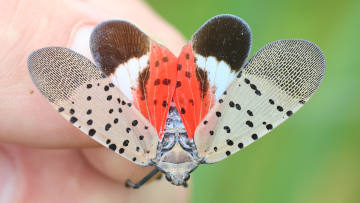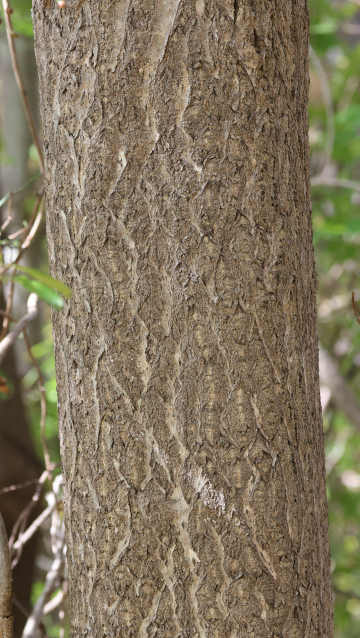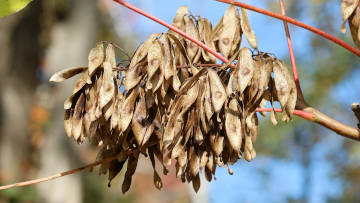Nature Notes

PHOTO COURTESY OF GARRY KESSLER
Spotted lanternfly adult with wings closed
June 20, 2025
NATURE NOTES
By Annie Reid
Westborough Community Land Trust
A Dubious Duo of Invasives in Our Region
These days, a dubious duo of invasives inhabits our region: a tree and an insect that feeds and reproduces on it. Maybe you’ve heard of them. The invasive tree is tree-of-heaven (Ailanthus altissima), sometimes just called ailanthus (pronounced eye-LAN-thus). It’s the main host for the reproduction of the spotted lanternfly (Lycorma delicatula), a large, colorful, flying insect, also invasive. You might mistake the flying insect for a butterfly or moth because its wings show patches of red, white, and black.
Tree-of-heaven, native to China, has been in this country since the 1750s, when it was first introduced in the Philadelphia area. Before its invasive nature was recognized, it was widely planted as an ornamental, shade, and street tree. In Massachusetts, its importation and propagation or sale were prohibited in 2006.

PHOTO COURTESY OF GARRY KESSLER
Spotted lanternfly adult with wings open
The spotted lanternfly, native to parts of Asia, is a much newer arrival. First detected in 2014 in Pennsylvania, it’s a planthopper, NOT a fly, butterfly, or moth. It quickly spread to 17 states, including Massachusetts in 2021. Now it’s found in our region, in Westborough, Shrewsbury, Southborough, Northborough, Marllborough, Grafton, and Hopkinton (see map). It feeds on the sap of plants, using mouthparts that pierce and suck. It does so in both its immature, wingless “nymph” stages and its adult (flying & reproducing) stage.
You might wonder, why worry about an invasive tree and an invasive insect that feeds on it? The problem is that the insect – the spotted lanternfly – also feeds on many other plants and weakens them. They include wild and cultivated grapevines and trees such as maples, black walnut, birches, willows, and more. The spotted lanternfly’s nymph stages, especially, feed on more than 100 plants.
How can you recognize these invasives? Start with the tree. Tree-of-heaven needs sunlight and grows rapidly. Find it in sunny disturbed areas, edges of woods, roadsides, agricultural fields, and forest gaps and fragments. It can grow 80 feet tall. It tolerates high and low temperatures, frost, drought, poor soils, and air pollution, but not shade. New trees sprout from roots and stumps, so you might find several trees together, all genetically identical. The roots also release chemicals that interfere with the growth of other plants.

PHOTO COURTESY OF GARRY KESSLER
Tree-of-heaven leaf with leaflets. The close-up in the inset shows a small gland at the base of a leaflet.
Look for tree-of-heaven’s long leaves (1-3 feet). Each leaf has 11-25 pointed leaflets (3-5 inches). They are arranged in pairs (but not quite opposite one another) along a main leaf stem. Be aware that black walnut trees (Juglans nigra), and staghorn sumac (Rhus hirta), and smooth sumac (Rhus glabra) shrubs have somewhat similar leaves, but their seed-bearing fruits are very different. (Black walnut trees produce nuts in hard green coats, and the sumacs bear upright, spire-like clusters of small red berries. Read about tree-of-heaven seeds below.)

PHOTO COURTESY OF GARRY KESSLER
Tree-of-heaven bark with diamond-like pattern
Tree-of-heaven’s bark is distinctive, sometimes described as looking like the skin of a cantaloupe. It is pale brown and smooth on young trees, but gray with a diamond-like pattern on older trees. On young trunks, you might notice leaf scars (where there once was a leaf) that are heart- or horseshoe-shaped (almost as if a little horse left hoofprints on the trunk).
Tree-of-heaven becomes more obvious when it flowers in late spring. Large clusters of small white flowers hang from its branch tips. Male and female flowers appear on separate trees, with “male” trees flowering more heavily.
You might also spot seed-bearing trees-of-heaven in mid-summer through fall. The “female” trees become noticeably loaded with large numbers of seeds, each in a single tan “wing” (1-2 inches). The wings are somewhat like those of maple seeds, but maple wings are paired, not single.

PHOTO COURTESY OF GARRY KESSLER
Tree-of-heaven seeds on the tree
Be on the lookout for adult spotted lanternflies from late summer through fall (August-December). They’re large, about an inch long and half an inch wide, and colorful in flight, with their red, gray, black, and white colors. Their flight is weak, as they fly or “hop” from place to place. At rest with wings closed, perhaps on a tree trunk or plant, they look gray with small black spots and blend in well with their surroundings.
Earlier (May-September), keep an eye out for the immature nymph stages, which have no wings but still spread widely to many kinds of plants, feeding as they go. Look for them on tree-of-heaven or nearby plants. At first (May-July), they are tiny, six-legged black bugs with white spots. Later (July-September), in their last stage, they are small red bugs with black and white spots. They may return to a tree-of-heaven. There, high in the crown of the tree, adult spotted lanternflies seek mates and lay egg masses (August-December). The egg masses have a mud-like covering and overwinter (September-June).
What makes tree-of-heaven attractive to spotted lanternflies? In short, spotted lanternflies may get protection by feeding on tree-of-heaven. The tree contains the chemical ailanthone, which helps to discourage plant-eating animals. Researchers are exploring the possibility that the same chemical also makes adult spotted lanternflies distasteful to predators (such as birds), which learn not to eat lanternflies. The adult spotted lanternfly’s flashy red color on its wings may serve to warn predators away from it.
For more information and photos of nymph stages and egg masses, check out this Homeowner’s Guide from the Massachusetts Department of Agricultural Resources.
As you enjoy summer, do yourself and your surroundings a favor by looking around for this dubious invasive duo of tree-of-heaven and spotted lanternfly. To report a spotted lanternfly sighting to state agencies, use this form.